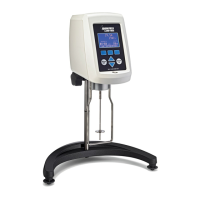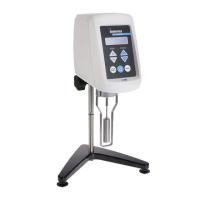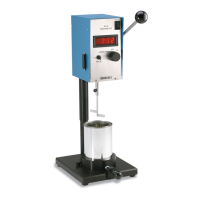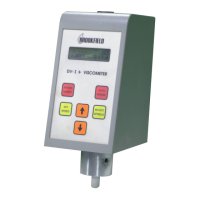Brookeld Engineering Laboratories, Inc. Page 16 Manual No. M00-151-I0614
APPENDIX B - Variables in Viscosity Measurements
As with any instrument measurement, there are variables that can affect a viscometer measurement.
These variables may be related to the instrument (viscometer), or the test uid. Variables related to
the test uid deal with the rheological properties of the uid, while instrument variables would include
the viscometer design and the spindle geometry system utilized.
Rheological Properties
Fluids have different rheological characteristics that can be described by viscometer measurements.
We can then work with these uids to suit our lab or process conditions.
There are two categories of uids:
Newtonian - These uids have the same viscosity at different Shear Rates (different RPM’s)
and are called Newtonian over the Shear Rate range they are measured.
Non-Newtonian - These uids have different viscosities at different shear rates (different RPM's).
They fall into two groups:
1) Time Independent non-Newtonian
2) Time Dependent non-Newtonian - The time dependency pertains to the
length of time the uid is measured at a given Shear Rate (rpm). Therefore,
these uids will exhibit changes in viscosity with both changes in shear
rate and the passage of time.
Time Independent
Pseudoplastic - A pseudoplastic material displays a decrease in viscosity with an increase
in shear rate, and is also known as “shear thinning”. If you take viscometer
readings from a low to a high RPM and then back to the low RPM, and
the readings fall upon themselves, the material is time independent
pseudoplastic and shear thinning.
Plastic - A plastic uid behaves as a solid under static conditions. A certain amount
of force, or "yield value," must be applied before the uid begins to ow.
Once this yield value is exceeded, ow begins. Plastic uids then may
display Newtonian, Pseudoplastic or Dilatant ow.
Dilatant - A dilatant uid increases in viscosity with an increase in shear rate (rpm).
Time Dependent
Thixotropic - A thixotropic material has decreasing viscosity under constant shear rate
(rpm). If you set a viscometer at a constant speed, recording cP values
over time and nd that the cP values decrease with time, the material is
thixotropic.
Rheopectic - A rheopectic uid has an increasing viscosity under a constant shear rate
(rpm).

